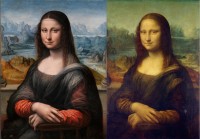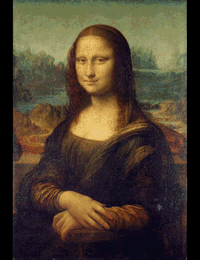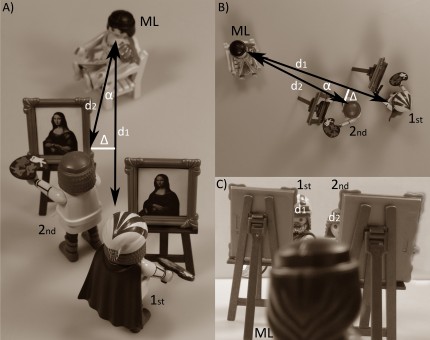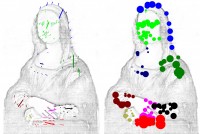 Two years ago, the Prado Museum in Madrid announced that a painting long thought to be a relatively unremarkable copy of Leonardo da Vinci’s Mona Lisa was actually painted contemporaneously with the original, likely by a student following the master as he drew and painted the portrait. Infrared reflectography found that the 18th century black overpaint obscured a hilly background almost the same as the original. When the black overpaint and varnish were removed from the Prado’s copy, further infrared and X-ray analysis found underdrawings and alterations from the tracing and all the way through the upper paint levels that matched those in 2004 scans of the Louvre Mona Lisa. That means from the initial sketches to the changes and corrections as painting progressed, the Prado copy followed along at each stage.
Two years ago, the Prado Museum in Madrid announced that a painting long thought to be a relatively unremarkable copy of Leonardo da Vinci’s Mona Lisa was actually painted contemporaneously with the original, likely by a student following the master as he drew and painted the portrait. Infrared reflectography found that the 18th century black overpaint obscured a hilly background almost the same as the original. When the black overpaint and varnish were removed from the Prado’s copy, further infrared and X-ray analysis found underdrawings and alterations from the tracing and all the way through the upper paint levels that matched those in 2004 scans of the Louvre Mona Lisa. That means from the initial sketches to the changes and corrections as painting progressed, the Prado copy followed along at each stage.
 That’s not to say they’re identical, even underneath the cracked and yellowed varnish that darkens and discolors the original. Two German researchers studied both paintings, selecting landmark points (like the tip of her nose, say, or a particular feature in the mountains) and mapping the path from the landmarks to the observer’s sight line. These trajectories tracked perspective changes between the two versions.
That’s not to say they’re identical, even underneath the cracked and yellowed varnish that darkens and discolors the original. Two German researchers studied both paintings, selecting landmark points (like the tip of her nose, say, or a particular feature in the mountains) and mapping the path from the landmarks to the observer’s sight line. These trajectories tracked perspective changes between the two versions.
They found that the background of the Prado painting, while virtually identical in shape, is 10% more zoomed in than the Louvre version’s. The expansion doesn’t follow a perspectival pattern you’d expect if the landscape were painted from life, which suggests the mountains in the background and the loggia right behind her were painted from a flat studio backdrop. The trajectories illustrated a number of perspective changes in the painting of the figure, particularly dense in Mona Lisa’s hands and head.
With the comparative perspective data, the researchers were able to calculate the positions of the canvases relative to the sitter and then they made a model of Leonardo’s studio during the painting of the Mona Lisa with Playmobil minifigs.

The original (labeled 1st) is further back and to the right of the Prado copy, and the horizontal distance between the versions is about 69.3 millimeters. The average distance between the eyes of Italian males is 64.1mm, a statistically insignificant difference which suggested to the researchers the possibility that the two paintings might have been deliberately positioned to be a stereoscopic pair which when viewed together give the impression of three dimensions
Carbon points out that Da Vinci “intensively worked on the 3D issue.” In addition, in inventory lists there were hints of the existence of two “Mona Lisa” paintings on his property at the same time, and that he owned colored spectacles, Carbon said.
This evidence “might indicate that he did not only [think] about the 3D issue theoretically but in a very practical sense in terms of experiments,” Carbon added. Also, when looking at the original colors of the two paintings the only real difference was in the sleeves, in which they are reddish in one version and greenish in the other. “This could be a hint to Leonardo’s approach to look at the two La Giocondas through red-green (red-cyan) spectacles,” he said, similar to those one might don to watch a 3D movie.
 That’s a lot of speculation and there are significant counterpoints refuting this hypothesis. The hands work as a stereoscopic pair because the trajectory differences are horizontal. Most of the trajectories on the upper portion of Mona Lisa’s body like her face and hair have a vertical orientation. Still, Leonardo did write about binocular vision and depth perception, so it’s possible he had some idea there could be a dimensional payoff in the positioning of the two canvases.
That’s a lot of speculation and there are significant counterpoints refuting this hypothesis. The hands work as a stereoscopic pair because the trajectory differences are horizontal. Most of the trajectories on the upper portion of Mona Lisa’s body like her face and hair have a vertical orientation. Still, Leonardo did write about binocular vision and depth perception, so it’s possible he had some idea there could be a dimensional payoff in the positioning of the two canvases.
You can read the whole paper here (pdf) to get the fully fleshed out argument with math and everything. It could all be pure imagination and it would be worth it for the minifig studio alone, as far as I’m concerned.